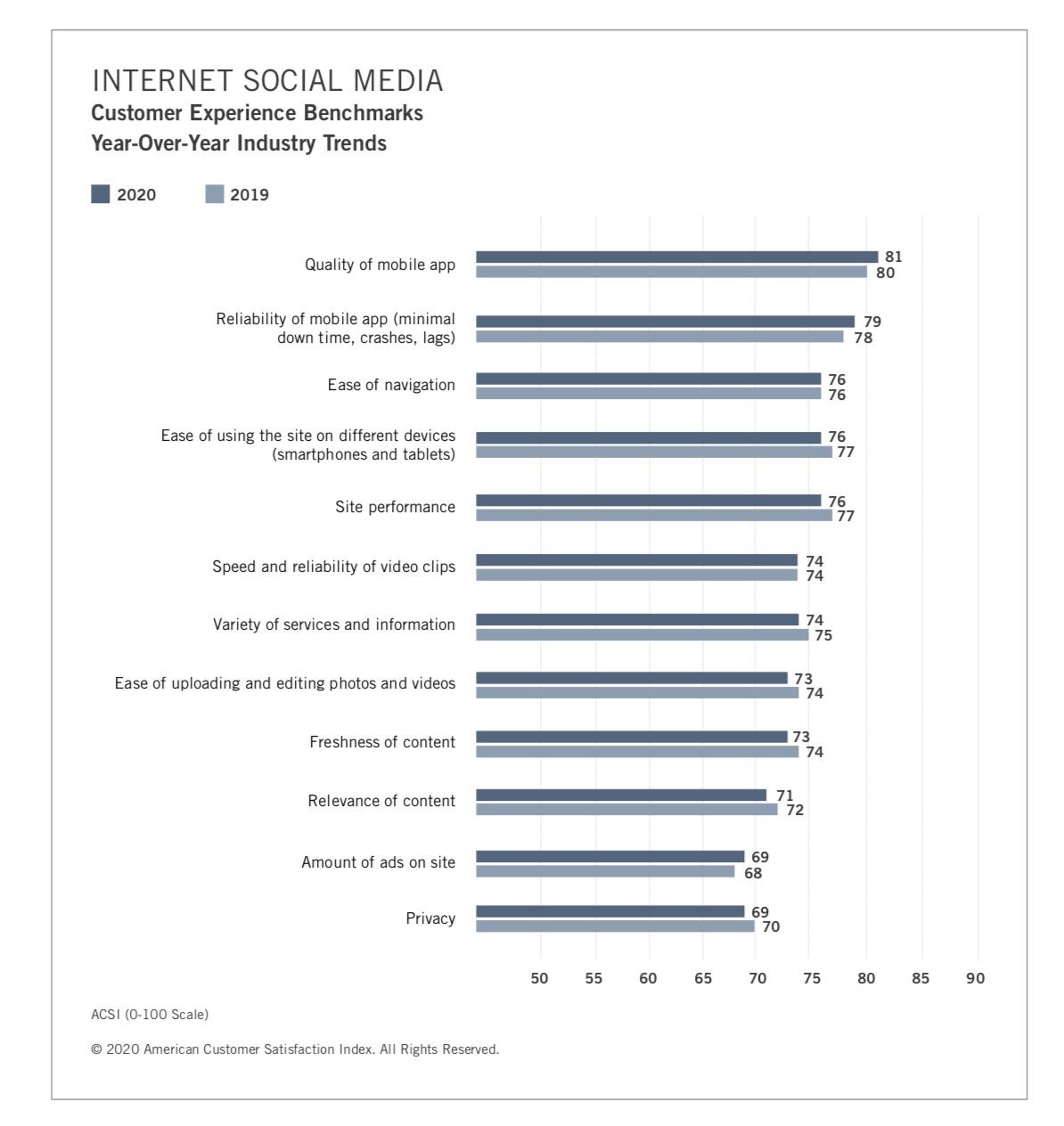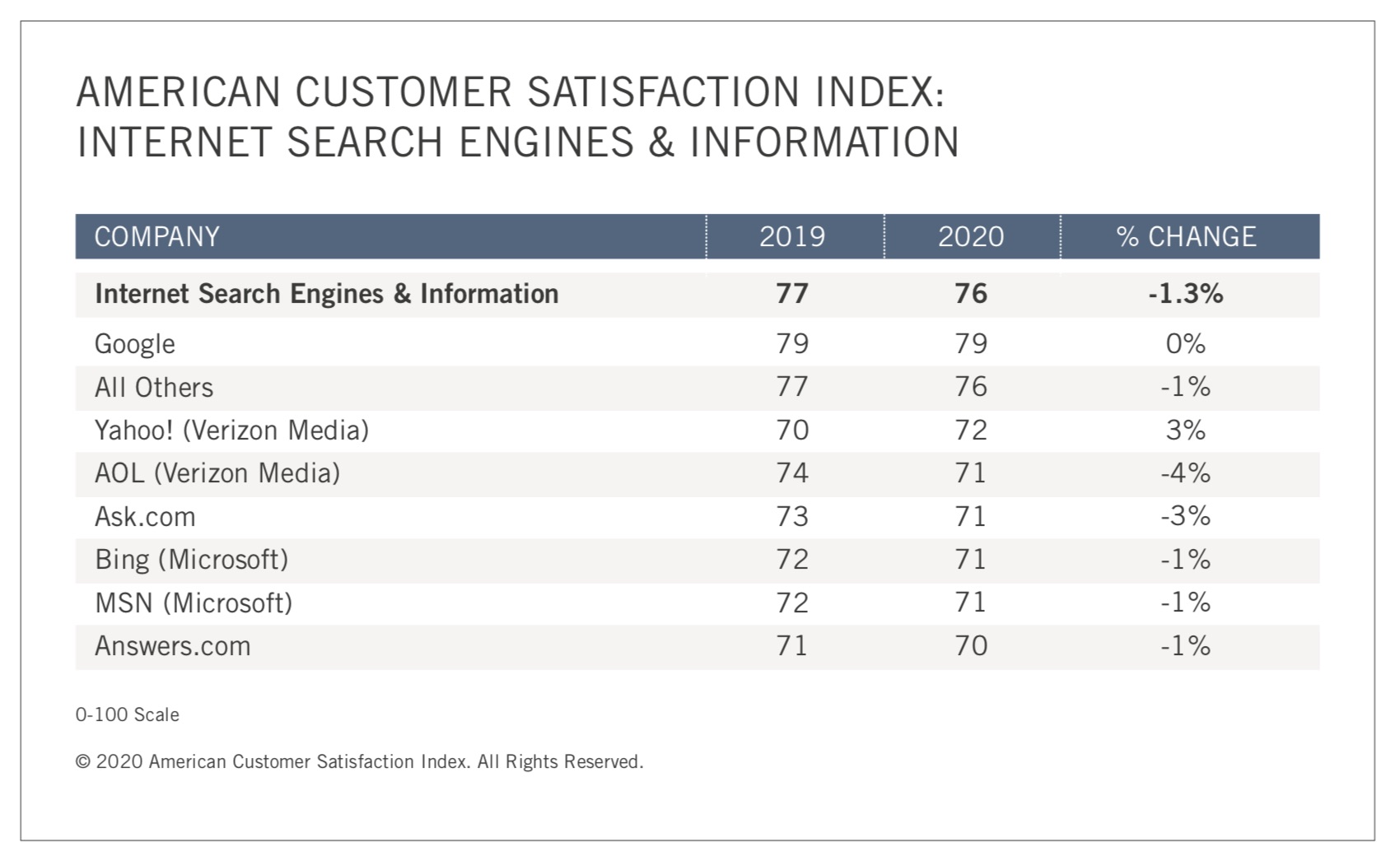Social media dominates so much of our time, from our personal lives to our careers. If you were an outside, alien observer, you would think that people were absolutely in love with it. Sadly, we’ve all known for years that the majority of people can use social media as a necessity, or even an addictive hobby, without enjoying it. This suspicion became a prominent field of research, with many citing stats about depression and anxiety such platforms can cause. Now, the American Customer Satisfaction Index has the numbers to show people aren’t particularly happy with many platforms.
The ACSI’s customer satisfaction report details the myriad reasons people are feeling down on apps like Facebook and Instagram. However, the decline in favourability has little to do with the quality of service, which has remained largely stable. Rather, consumers are feeling concerns about data privacy (or lack thereof), ad clutter, and the freshness of content. This has caused the entire social media industry to receive poor customer satisfaction ratings, rivalling those of TV and Internet service providers. It’s not a good sign when your customer perception is in the same league as AT&T and Time Warner.
Let’s take a closer look and examine just how customers view platforms. Moreover, we’re not here to kick platforms when they’re down, but rather to see how companies can improve these perceptions. Additionally, since social media is so entrenched in the modern marketing ecosystem, it has ripple effects for every other business. It’s important to understand how these perception changes might affect your online marketing strategy.
The Customer Satisfaction Numbers Speak For Themselves

Overall, the ACSI e-business report has shown middling satisfactions across a majority of larger social media platforms. It bears mentioning that companies like Facebook and Tumblr have seen increases from the previous year. However, the current numbers are not very promising for companies that have large, global customer bases. A longer trend analysis shows an overall decline across multiple years. Having over one-third of your billion-strong customer base dissatisfied is a major issue, especially when it comes to planning how to mitigate it.
Another reason to consider these numbers in a negative light is that the major platforms are all lagging behind while smaller entrants are creeping up. Traditional social media platforms are taking a backseat to more specialist formats like Pinterest or Snapchat. This type of social media format with a direct focus is in vogue these days (a factor we’ve previously covered multiple times). Basically, companies with a particular niche are faring better than large ones like LinkedIn or Facebook, which aim for a broad base.
Overall, there has been a 2.8% decline for all platforms put together, which doesn’t bode well for the industry. The largest fall decline has been for Youtube, with major content gaffes and dissatisfactions with corporate decisions. Many users and creators on Youtube have voiced their discontent with demonetisation, celebrity channels receiving more focus from the company (particularly during the Youtube Rewind last year), and inappropriate content causing concerns of political violence.
Similarly, Facebook saw a dip over the years before 2019 due to the Cambridge Analytica scandal. The company took on a $5 billion fine at the hands of the Federal Trade Commission and major losses in consumer trust. Recently, they have been recovering and seeing improved customer perception.
Privacy Concerns Top the Bill

As mentioned earlier, users’ main concern is of data privacy. User assessments for this metric have hit an all-time low of 69%. Recent events have not made things better, with major political scandals and long periods of inaction towards fake news proliferation. For years, Facebook has trailed in this regard, with the lowest score on customer privacy.
As the report states:
Facebook has faced a string of controversies surrounding privacy, security lapses, violent rhetoric, and fake news. From the Cambridge Analytica scandal in 2018 to the recent advertising boycotts, the company has encountered waves of negative publicity.
It seems that privacy concerns are not going to go away anytime soon. July saw Twitter undergo a massive private security breach that the company had to address publicly. Twitter has been notorious for having a lax attitude towards harassment, doxing and customer concerns in general. This latest incident is an unfortunate setback for a company that already has a shaky reputation for data privacy.
In general, user experience metrics are going down as well. The variety of features, site performance and ease of uploading are all faring worse in customer assessments. Additionally, the freshness of content has been on the decline as well, with LinkedIn coming out especially worse for wear. Alternatively, the quality of mobile apps is doing better than the previous years. Amount of ads are gaining higher satisfaction scores, but companies like Facebook have been doing worse individually.
Search Engines & News Organisations Suffer

Across the board, there have been decreases in customer satisfaction, aside from Yahoo and Google. The majority of the dissatisfaction comes from the abundance of advertising. This may be due to how much sponsored content companies push, which is bolstered by changes in visual design to accommodate ads. However, ad quality has seen a better customer rating despite the dissatisfaction with the number of ads.
That said, search engines are doing fairly well on a number of metrics. Search engines and information sites have excellent mobile apps, with high ratings for quality (84) and reliability (83). Search engines are easy to use on different devices (80) as well. While navigation dips to 80, this remains a strong score, along with site performance (80).
News sites have also suffered major setbacks in consumer perception. The only metric that has not fallen is the quality of mobile apps. Although usage surged during the pandemic, there has been a dramatic decrease for several prominent news companies. Companies like the NYTimes have gone through major scandals and boycotts, which hampered their levels of trust among consumers. Major news companies are also suffering due to a general mistrust of news online, largely due to fears of disinformation.
How Social Media Decline Affects Stakeholders
Stakeholders can be a very vague word, so it might be best to clarify a little bit more. Stakeholders, in this case, form a lot of relevant parties that use social media services. This includes advertisers, businesses running storefronts on social media, news organisations etc. The major content producers that keep social media flowing and have a symbiotic business relationship with it are also included.
The most obvious way in which this affects businesses advertising on platforms is social media fatigue. Consumers will migrate to other platforms or simply go offline, crippling a major source of marketing communication. Sadly, advertising is only exacerbating customer dissatisfaction, as most consumers are not fond of the levels of commercialisation they encounter online. A counter-effect of this factor may be advertisers adopting different types of promotion that are less overt. This could be influencer marketing or other forms that provide some entertaining content that seems more natural. There are smart ways around it.
Social media users that rely on platforms for their income have it fairly worse. A lot of tech companies can make changes to their algorithm or their layout that cause major headaches. This can result in the need to change formats, readjust strategies, place emphasis on different areas of online strategy etc. As a result, a company’s attempts to fix customer satisfaction may cause ripple effects that impact social media marketers.
News companies can also suffer from similar problems. Continued customer dissatisfaction is sometimes tied to the abundance of false information online. An increase in customer dissatisfaction therefore sometimes correlates to distrust of information online. New companies in general can suffer from this sort of distrust. Companies like Facebook have been trying to mitigate this by having fact-check suggestions. Similarly, Twitter is clamping down on certain types of harmful disinformation, especially about the Covid pandemic.
How Platforms Can Boost Customer Satisfaction
Platforms can look to some key areas for improvement. Mainly, they need to improve privacy and be more transparent about what measures they take. Prevention of breaches should be the main concern when it comes to patching security. Another issue is the over-abundance of advertising, which is becoming intrusive for many users.
Users say they want to see better media performance when it comes to online video. They want faster and more reliable video performance on platforms. Similarly, the ease of uploading has declined in previous years but it could improve by streamlining the process and making it less complicated. This could also solve another major concern, which is the freshness of content. If the content is easier to upload, it could result in better standings on this metric.
Harassment, fake news, and hate speech are also hobbling companies like Facebook and Twitter. This is trickier to handle and may require cooperation with fact-checkers and lawmakers. This raises issues for free speech and what counts as trustworthy information, but it is a problem that is looming over all of the social media. These are more complex issues to solve and there is no easy solution for them. That said, making drastic changes will be necessary if they ever want to turn their consumer satisfaction numbers around.


